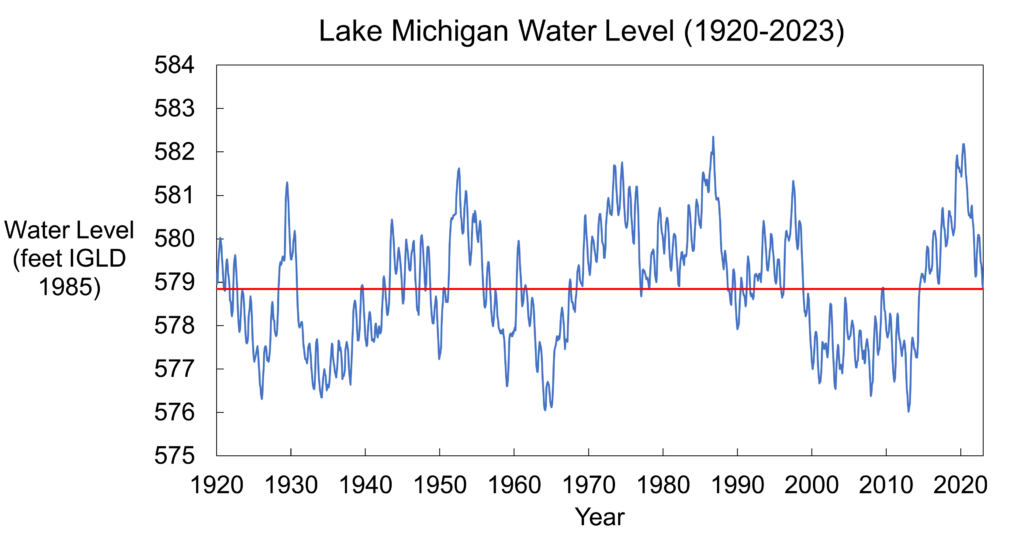
Through the late fall (November) and winter (December, January and February), Lake Michigan water levels continued their seasonal decline. Water levels are expected to begin their seasonal rise in late March or early April. Over the past year, Lake Michigan experienced below average precipitation. Warm early winter temperatures have led to below average evaporation and low ice formation across the Great Lakes.
Water Levels on Lake Michigan-Huron
Here are five things to know about water levels on Lake Michigan for Winter 2024.
What are the current water levels on Lake Michigan?
The water level of Lake Michigan as of March 1, 2024, was at an elevation of 578.54 feet above sea level (from the International Great Lakes Datum). To put this level into perspective, here are some statistics for Lake Michigan relative to the period of water level records measured from 1918 to present (statistics from USACE’s Weekly Water Level Update and USACE’s Water Level Summary).
| Compared to… | Current Water Levels are… |
| One month ago | 3 inches lower |
| One year ago | 3 inches lowerer |
| Long-term March monthly average (1918 to 2022) | 1 inch lower |
| Record March monthly mean (set in 1986) | 35 inches lower |
What is the outlook for future water levels?
Over the fall and winter, Lake Michigan water levels have continued to decrease. The USACE is projecting that water levels are expected to rise one inch by the end of March. The USACE 6-month forecast of Great Lakes Water levels shows an expected spring-time increase in water levels to the regular summer peak (see the water level forecast issued for March 2024 below). Over the next 6 months, Lake Michigan water levels are projected to remain near long term average water levels. The image below shows the projected water levels in green, past water levels in red, and long-term average water levels in blue.
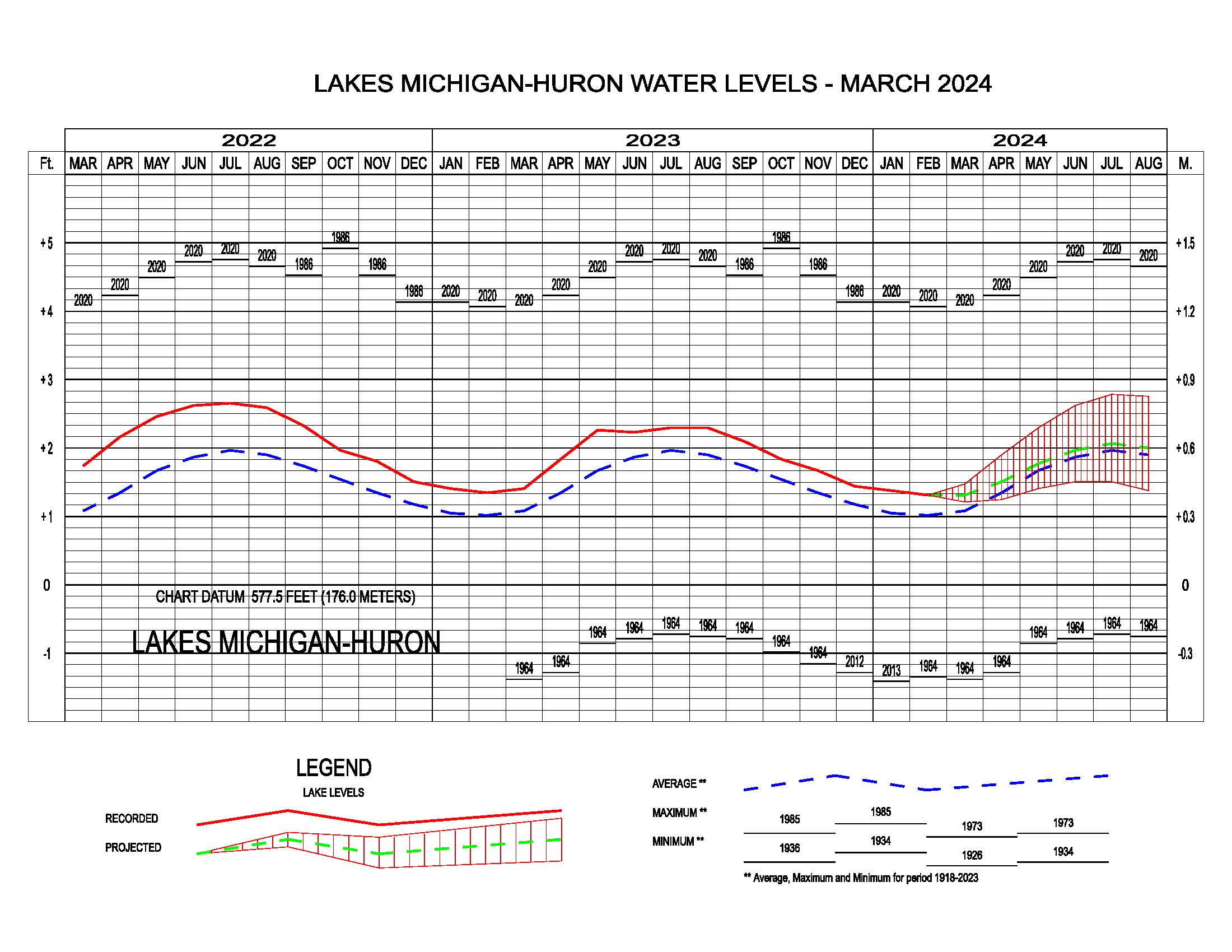
USACE six-month water level forecast for Lake Michigan-Huron retrieved for March 2024 from: https://www.lre.usace.army.mil/Missions/Great-Lakes-Information/Great-Lakes-Water-Levels/Water-Level-Forecast/
Additionally, we remain in El Niño. Typically, El Niño brings above-normal temperatures and possibly drier conditions to the Great Lakes region. It’s predicted that above average temperatures brought on by El Niño will persist over the next month for the Great Lakes. El Niño can lead to less precipitation and runoff into the Lakes this spring, which would lead to lower water levels. NOAA’s Climate Prediction Center is anticipating near normal to below-normal precipitation over the next month (see precipitation outlook map from NOAA Climate.gov below). Check out the NOAA Climate Prediction Center’s U.S. climate outlook for March 2024.
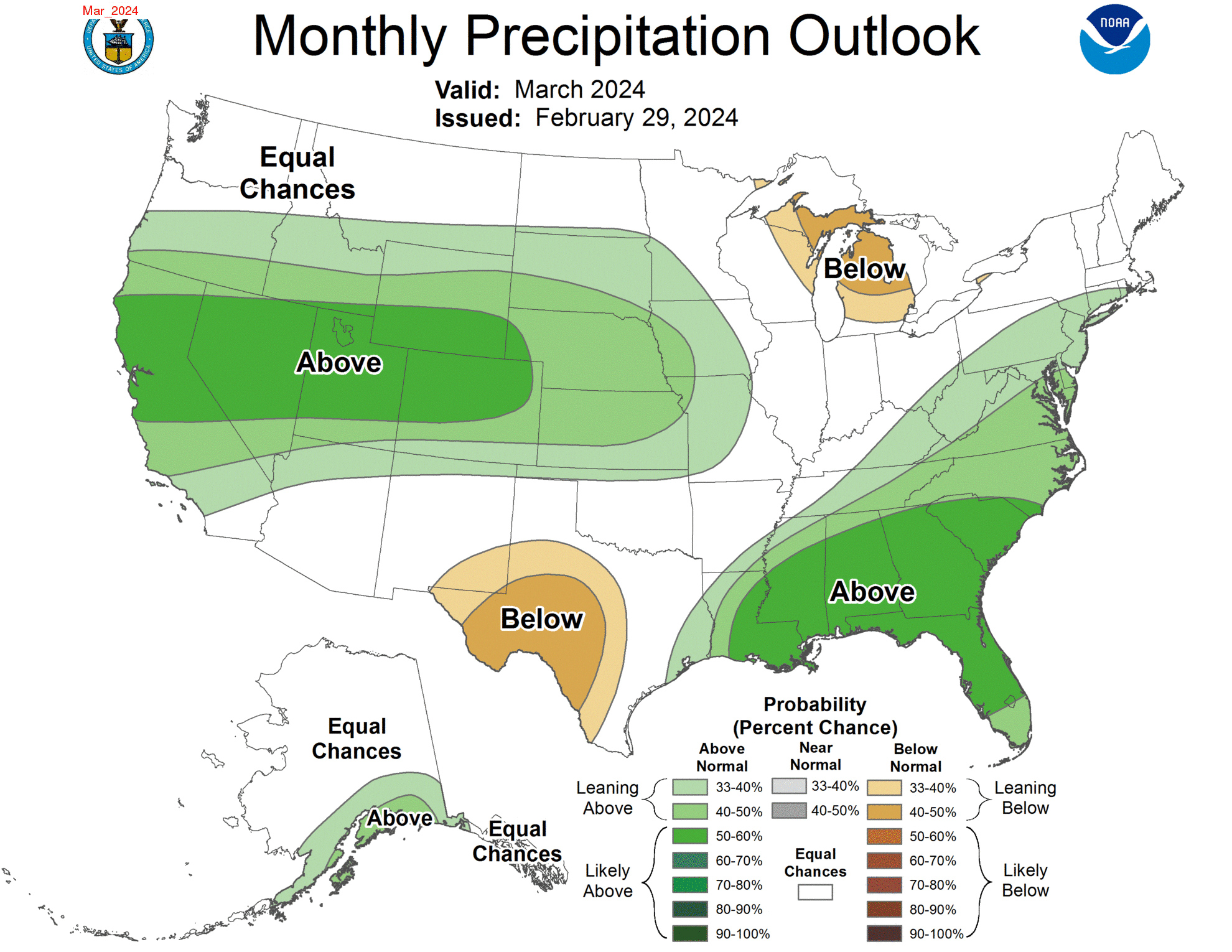
The U.S. precipitation outlook for March 2024. Map by NOAA Climate.gov, based on data from the Climate Prediction Center. From: https://www.climate.gov/news-features/understanding-climate/us-climate-outlook-march-2024
What is behind Great Lakes water level fluctuations?
The story of Great Lakes water level changes is told by Net Basin Supply. Net Basin Supply (NBS) accounts for the water going into a lake in the form of precipitation and runoff minus water leaving a lake due to evaporation of water from the lake surface.
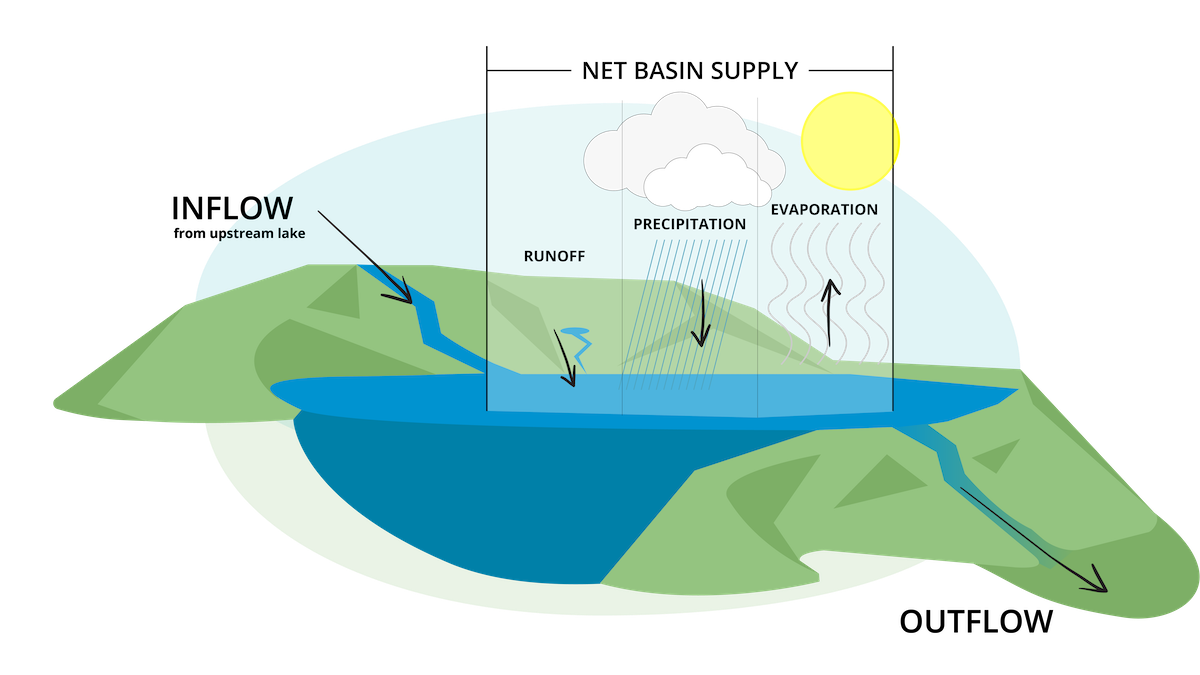
NBS represents the net influence of precipitation over the lake, runoff from a lake’s watershed into the lake, and evaporation from the lake’s surface. Image credit: National Oceanic and Atmospheric Administration
In general, when Net Basin Supply is positive, more water enters the lake than leaves, causing a rise in lake levels. When Net Basin Supply is negative, more water leaves the lake than enters, causing a drop in lake levels. (Click here for more detail).
The annual peak Net Basin Supply occurs when runoff peaks in the spring and experiences its minimum when over-lake evaporation peaks in the winter. These maximums and minimums in Net Basin Supply correspond to the seasonal water level rise and fall. (Click here for more detail).
Evaporation takes place when the Lake’s surface water temperature is warmer than the air temperature. Though Lake Michigan had low ice cover this year which left the water surface open to evaporation, evaporation was well below average in December (see USACE graphic on monthly evaporation rates below) and only slightly above average in January and February. This is due to a relatively small difference between the air temperatures and lake surface temperatures in recent months.
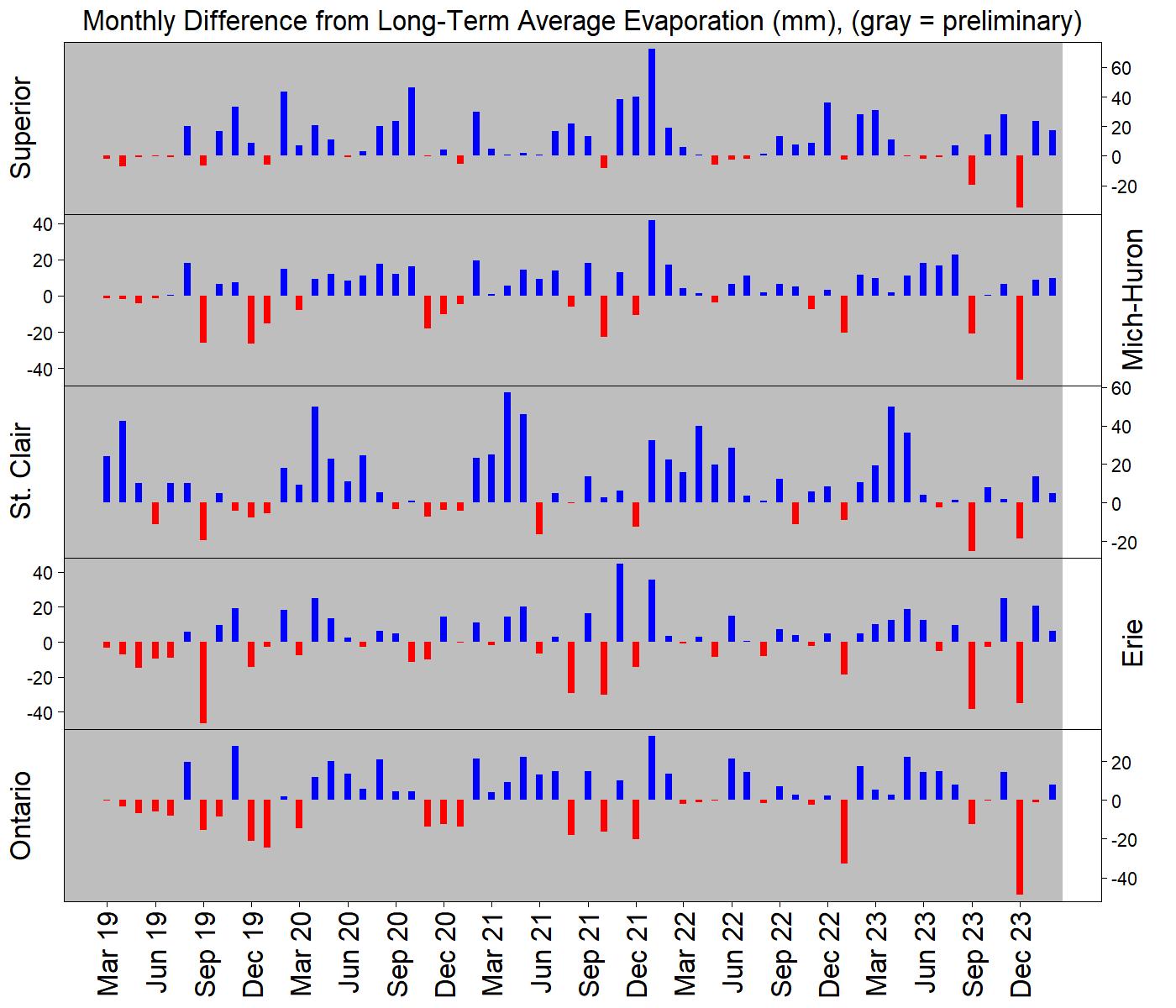
Evaporation relative to long term average Evaporation for the past 5 years. Retrieved from: https://www.lre.usace.army.mil/Missions/Great-Lakes-Information/Great-Lakes-Information-2/Basin-Conditions/
What is making water levels go down?
Since monthly record highs in 2020, the Great Lakes water levels have been trending downwards. This trend has continued and water levels are lower than they were at the same time in 2022 due in part to below average precipitation over the past year. However, water levels still remain above the long term average. The graph below visualizes the monthly difference from the long-term average NBS for the past five years. Red bars represent below average NBS, whereas blue bars represent above average NBS.
Water level fluctuation is a process that occurs annually due to changes in net basin supply. Water supplies have been fairly balanced throughout the winter, with no months extremely out of balance. This has led to a seasonal water level decline that has been relatively consistent with the long-term average trend.
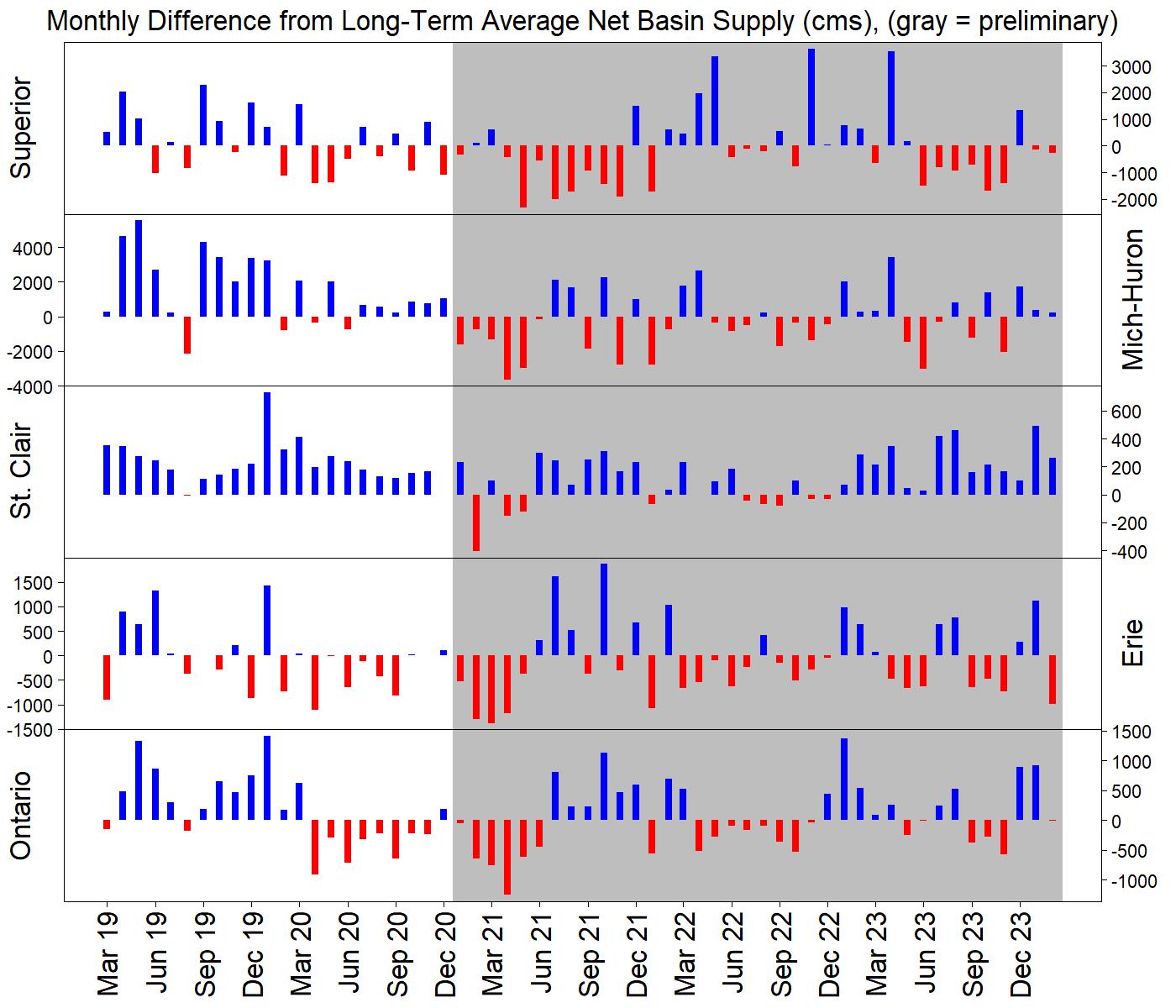
NBS relative to long term average NBS for the past 5 years. Retrieved from: https://www.lre.usace.army.mil/Missions/Great-Lakes-Information/Great-Lakes-Information-2/Basin-Conditions/
What lake conditions are typical for this season?
Ice cover has been extremely low during the 2023-2024 ice season. Our current winter season began with very warm air temperatures, resulting in low ice formation. Because ice cover prevents evaporation, a lack of ice creates the possibility for lake effect snow. Additionally, ice can provide protection to the coastline from erosion and flooding during storms. Without ice to diffuse wave energy, waves can continue to erode and runup on the coastline.
Below is a time-lapse video of Lake Michigan from Chicago, Illinois, showing moisture evaporating from Lake Michigan that has been contributing to lake-effect snow (Aleks Phillips, U.S. Newsweek).
Places you can find more relevant information:
- In this Adapting to A Changing Coast PBS Special, Dr. Adam Bechle dives into how coastal flooding is impacted by water levels, ice, and storms (start at 24:50).
- The Great Lakes Ice Cover page from the Great Lakes Environmental Research Laboratory (GLERL) hosts historical, current, and forecasted ice cover information.
- NOAA’s Climate.gov site hosts climate data and information to help you understand climate processes and make decisions on how to manage climate-related risks and opportunities.
- U.S. Climate outlook for March 2024
- El Niño and La Niña
- Polar Vortex Blog
- Great Lakes Chapter of the Climate Resilience Toolkit
- Our Great Lakes Coastal Processes blog has posts to help understand the physical and hydrologic processes impacting water levels and hazards including:
- Ice
- Frost-Heave
- Evaporation
- Waves & Coastal Storms
- Our Policy, Planning, and Risk Reduction Strategies page has tools and resources to help local governments identify local resilience opportunities.




